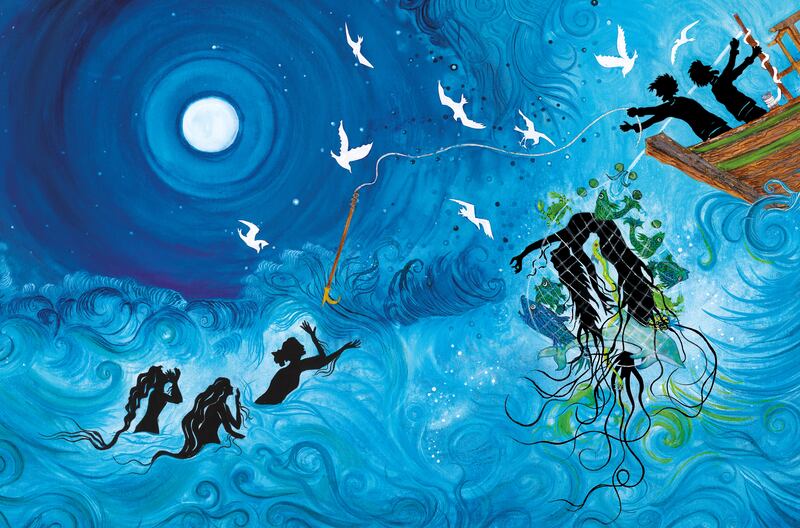In Paradise Springs, a small Californian town home to winemakers and, perhaps – if one believes – to mute ghosts, the Fall siblings hurt in their different ways. Twelve-year-old Dizzy, dreamy and chatty, finds herself silent after being abandoned by her best friend: “She didn’t know that people could stop loving you. She’d thought friendship was permanent, like matter.”
Her seventeen-year-old brother, known as Perfect Miles to the outside world, “suspected he was in the wrong body, family, town, species, that there’d been some big cosmic mix-up. Like maybe he was supposed to be a tree or a barn owl or a prime number.” And the eldest Fall, Wynton, 19 and fresh out of jail, “was just in the wrong tempo, the wrong key”.
Enter Cassidy, known only at first as “the Rainbow-Haired Girl”, who steps in to save each of the siblings in turn, veering dangerously close to Manic Pixie Dream Girl territory before having the chance to share her own narrative. “All women write stories,” she declares. “It’s just that only some transcribe them.”
Cassidy reveals a childhood spent on the move, with only her beloved, though troubled, mother for company, but has also pieced together a chronicle of the Fall family curse – related as a fairy tale but carrying more than a grain of truth beneath the romantic flourishes.
Whimsy, magic, love, grief, siblings, a devotion to the Californian landscape – it could only be the new Jandy Nelson novel, When the World Tips Over (Walker Books, £8.99), the much-anticipated follow-up to the critically acclaimed I’ll Give You the Sun and The Sky Is Everywhere. Almost 10 years in the making, it shares obvious DNA with its predecessors – there is the same hopeful, tender case made for the power of love amid soul-ache, the same careful balance between yearning adolescents and the imperfect adults who both cause and alleviate psychic pain.
There are resonances, too, with another magical-small-town tale published this year; this is the sunshine-infused West Coast answer to Kelly Link’s The Book of Love, a chunky book to lose yourself in and to occasionally swoon over, in between gasping and worrying for the characters and possibly doing some undignified sobbing.
We are in such good hands with Nelson, whose lyricism elevates the potentially cloying (souffles that make people fall in love, magical vines smuggled from a repressive village) into something utterly compelling. She can even – surely evidence of literary witchcraft on her part – get away with having a telepathic dog in the story. A delirious, intoxicating spell of a book, destined to end up on many important award lists and to firmly lodge itself within many, many hearts.

The iconic British children’s writer Berlie Doherty (Granny Was A Buffer Girl, Dear Nobody), who counts two Carnegie Medals among her cornucopia of prizes, is going strong after more than 40 years of publishing. Her latest work, The Seamaiden’s Odyssey (UCLan Publishing, £14.99), is a mermaid-themed novella drawing particularly on English folklore about sea creatures – it is inevitable that readers will think of Andersen’s The Little Mermaid when first encountering Merryn, the restless youngest daughter of the Sea Lord, but weaving in elements of the river hag Jenny Greenteeth gives the story its particular flavour.
“She would be a water witch, she would be feared and hated ... and she would always be alone. And yet, the salt water of the sea still coursed through her veins like lifeblood, and the sigh of the tide whispered in her ears, giving her back her song with all its sadness and longing.”
The fable-like narrative is accompanied by dreamy, swirly illustrations by emerging illustrator Tamsin Roswell; the whole book is beautifully produced, with blue-edged pages luring us down to the water with the characters. A framing device – Merryn’s account comes to us via a strange girl who is cared for, and then trapped within, a sanctuary for sea creatures – is slightly underutilised, though still manages to nod to Doherty’s passion for conservationism. Overall, a gorgeous treat.
The use of the fantastical to gently invite readers to consider our own environment, and humankind’s ongoing damaging of it, pops up too in the latest collaboration between Costa-Award-winning Frances Hardinge and Greenaway-Medal-winning Emily Gravett. The Forest of a Thousand Eyes (Two Hoots, £14.99) follows last year’s team effort, The Island of Whispers, and features a typical strange-yet-resilient Hardinge heroine. “Feather was used to the Forest trying to kill her. Snakes, giant eagles, poison thorns, hurricanes. That was normal. But people didn’t try to kill you.”
Feather’s attempts to help a stranger lead to a near-death experience and propel her on to a quest to return a stolen spyglass to her small community. As she tracks the thief through the vast, wild Forest, she encounters other bands of humans, all with their own distinct ways of living. “What did they think of her, the first stranger they’d spoken with? A dogged, haggard girl wandering in from beyond the edge of their world, her hair full of sap, her skin full of thorns, her mouth full of impossible stories. A girl who gobbled any food they would give her, asked more questions than she answered, and refused to stay.”
The green-hued pencil-style illustrations from Gravett enrich the story immensely, often winding around the text like tree branches. Haunting and memorable.

In the Paris-inspired shadowy city of Fantome, two rival guilds roam. The Cloaks are thieves, the Daggers assassins, and both are fuelled by a “fine black powder” known as Shade, “a volatile substance that bent shadows to the will of man”. First discovered by a pair of brothers many years before the story begins, it is the driving force behind much of Catherine Doyle’s latest fantasy adventure, The Dagger and the Flame (Simon & Schuster, £12.99).
Much of the strongest writing here is about the power of Shade, neatly paralleling drug addiction. “It takes away the bridge between magic and mortality, until there’s no going back to who you were before,” Ransom, a Dagger, tells Sera, the girl he’s been sent to murder, though at this point – naturally – he’s already falling in love with her. The familiar romantasy tropes abound when it comes to their relationship but it’s a fun read nonetheless.
“I want you to know that there is a space called poetry / and if it interests you / if you’re the sort of person whose head is filled with / ideas and feelings / that don’t seem to match curricular targets / I want you to know there’s a space called poetry / and this space will always be here.
The new collection from CliPPA-winning Matt Goodfellow, Tomorrow We Begin (Bloomsbury, £7.99), opens with this earnest but gentle invitation to readers. All readers, in theory, but implicitly it is an invitation particularly aimed at young men, boys in their early teens heading off to new schools and trying to grapple with a world that does not encourage their emotional awareness.
It’s a reassurance for anyone who does not see the role of “a man of hammers / spanners / and neatly labelled plastic boxes of screws” in their future, who feels like “an ungainly suitcase of disappointment”. Accessible, conversational, and wry – essential school library material.















